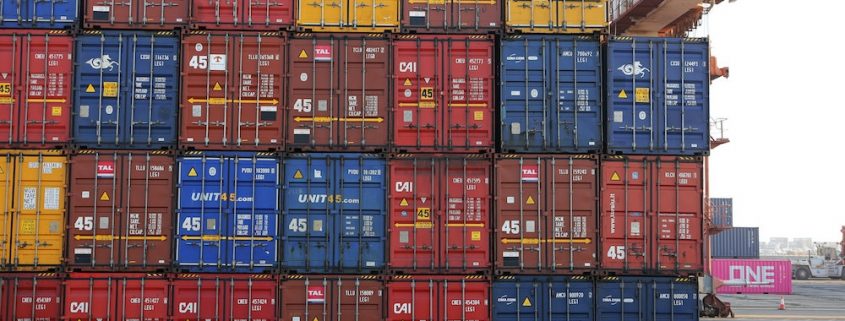Historic Cargo Shipwrecks from the Cargo Container Pros
Approaching Halloween, many of us are looking for something scary to indulge in, and Moon is always aiming to deliver! Cargo ship and freighter wrecks can be scary and disastrous in many ways, considering how large cargo ships usually are, how many different kinds of products they carry, and how much money was spent on those products. When a cargo ship wrecks, not only can it have dire environmental effects and compromise the safety of the crew, but it can throw the economy and supply and demand out of whack with missing products or, in one very recent case, a backed-up canal.
As a company with decades of experience buying, selling and renting a cargo container, the Moon Company team is your “go to” on cargo shipping containers. Follow along for details about 8 cargo ship wrecks across history to accompany this Halloween season!
The Ancient Wreck
This Roman cargo ship wrecked more than 2,000 years ago, yet the goods aboard still survived. The ship carrying hundreds of ancient Roman jars called ‘amphorae’ was estimated to be more than 20 meters long and sailed through the 1st or 2nd century BC. Talk about the ancestor of today’s cargo ships!
The Leader L
In 2000, tragedy struck a 776 foot cargo ship carrying salt called the Leader L off of the coast of Bermuda, where it sank within hours and took the lives of 18 crewmembers. Caused by a loose steel hull plate that allowed the hold to flood and sink the ship, this sunken ship has the highest death count on the list, with only 13 of the 31 crew members found alive, 6 found tragically lost, and the other 12 crewmen having been missing and presumed dead the night of the wreck after a full day of search and rescue.
The Hanjin Pennsylvania
Wrecked with an onboard explosion in 2002 off of Sri Lanka, the Hanjin Pennsylvania was a terrible wreck because of the cargo it carried. After 4 days of burning on the open sea, the fire reached one or more containers that contained fireworks and were mis-declared on the ship’s manifesto. This prompted a 2nd explosion and, in total, the explosions took the lives of 2 crew members.
The MSC Napoli
The MSC Napoli wrecked on January 18th, 2007 due to stormy weather and 30 foot tall waves damaging the hull in way of the engine room. The crew abandoned ship and all survived, but so did the toxic materials and oil that began leaking into the ocean, contaminating the waters until the government was able to remove most of the substances. The ship lost 114 containers and 80 of them washed up on shore and were pillaged. The accident was deemed the 2nd most expensive wreck at the time, costing approximately $127.3 million and the salvage taking 924 days in total.
The Rena Disaster
As a cargo wreck with one of the worst ecological impacts, the 2011 wreck of the Rena grounded on the popular and ecologically-important Astrolabe Reef in the Bay of Plenty located on New Zealand’s coast. This wreck was especially damaging due to the oil spill that began almost immediately after the grounding, releasing 200 tons of heavy fuel, and the fact that the cargo ship was carrying 1,386 containers – 11 of which were carrying hazardous substances like ferrosilicon, a material that reacts and ignites upon contact with water.
MOL Comfort
Between June and July of 2013, the MOL Comfort’s cargo losses is one the the largest recorded in modern maritime history. This 5-year old ship broke in two in the Indian Ocean while carrying more than 4,000 containers. Of it’s cargo, it is estimated that 4,293 containers were lost, and this incident inspired the adoptions of new rules regarding the hull girder strength for large container ships.
Maersk Honam
The Maersk Honam was both one of the youngest and one of the largest cargo ships to wreck in recent history. The 1,158-foot ship was carrying 7,860 containers when a fire broke out in one of the cargo holds in March of 2018 as it sailed in the Arabian Sea. 4 crew members died and one was missing until declared dead as a result of the accident, and after evacuation, the fire spread to the entire cargo area and was so large that it could be seen from space.
Ever Given
In the height of a pandemic-fueled supply and shipping demand in 2021, the Ever Given grounded horizontally in the Suez Canal in Egypt when it veered off-course due to poor visibility in a sandstorm. Traffic in the canal, which handles 12% of global trade, came to a stop because of the position, and by the time the Ever Given was refloated, the backup amounted to more than 400 ships. While none of the crew was lost, the ship didn’t sustain major damage, and all cargo was left intact, the backup of such a large amount of cargo ships unable to deliver their goods threw a major wrench in the world’s economy and supply chain, costing upwards of $9 billion a day.
If you are looking for shipping container rentals or purchasing options in Kentucky or Southern Indiana, consider giving Moon Trailer Leasing a call. Our experienced team has decades of experience serving the needs of customers throughout Louisville, Lexington, Clarksville, Jeffersonville, and New Albany. We also specialize in other related services including portable restroom and shower rentals, dumpster rentals, refrigerated container rentals and more. For additional details or to get a fast and easy quote for your project, give us a call at 502-776-2199. “Ask for the Moon, and get it!”











